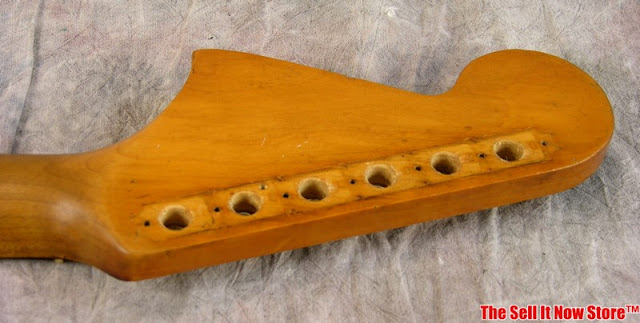So I guess I'm on a bit of a roll. Two posts in less than a week. Here's a '64 Jaguar which is going be the second installment in my "Used Cars" series. This model was the Top-of-the-Line guitar in the 1964 Fender catalogue, and I've always wondered if I could build a vintage Fender Jaguar for less than it would cost me to buy one. The answer is yes, but it took me over three years to find all the parts at reasonable prices.
I started off with a '64 body and pickguard that I picked up from the same seller. It had a horrible copper paint job but I was hoping the original finish might still be underneath after I found the typical vintage Sunburst pattern under the painted brass grounding plates.
The tortoise shell pickguard is a wonderful reddish brown colour with a lot of depth, but had several cracks that I reinforced from behind with aluminum tape which also provides shielding for the pickups.
I stripped the body and found all the "factory correct" tooling marks made during production, but no luck finding the original sunburst finish underneath.

The B width neck is date stamped DEC 1964. It is well worn, but still has the original frets and nut.
The pickups have the short-lived yellow stamped date code and were made by pickup winder CO on Oct 21 '64, too bad they were missing the pickup covers and claws.
I found a matched set of upper and lower control plates with the factory wiring harnesses still intact and pots dating to the 20th week of 1963.
Vintage bridge and Patent No. 2,972,923 vibrato and arm.
L-series neck plate with correct 2 inch screws.
At this point I had almost all the vintage correct parts I needed to complete my 1964 Fender Jaguar. The only new parts I used were repro Kluson tuners, aged pickup covers & claws, and a funky toggle switch plate featuring the Wronski mod. It's named after surf guitarist Dave Wronski and made by Paul Rhoney Guitars. It is a stock size Jaguar toggle plate but cut for a Tele switch instead of the three standard slider switches. Similar to the Johnny Marr mod, but it's on a diagonal and requires no alteration of the cavity.
I decided to finish the guitar in black lacquer just because it goes so well with a tortoise shell pickguard, and to lightly age the body to match the wear on the rest of the parts. The cavities and neck pocket were left unfinished.
Now to install the brass grounding plates, pickups, and rewire it all with correctly coloured cloth push back wire.
1964 Jaguar back on the road again.





























































